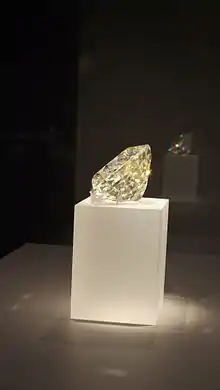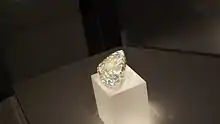Light of the Desert
The Light of the Desert is a cerussite gem in the Royal Ontario Museum's collection. It is the world’s largest faceted example of cerussite, weighing 898 carats (6.3 ounces).[1] The word "cerussite" comes from the Latin meaning "white lead"; the mineral is a lead carbonate with the chemical formula of PbCO3.[2] The raw cerussite was discovered in Tsumeb in northern Namibia and acquired by a gem cutter from Arizona who then cut the raw material into the gem on display. The cutting and transport of this gem is a delicate business as cerussite is extremely fragile and sensitive to temperature changes and vibration. After it was cut in Arizona, the gem was placed in a box, then wrapped in a large woolen scarf and a winter vest, and then hand transported to Toronto for display.[3] Cerussite is too fragile to be set in jewelry.


Cerussite is known for its dispersion (or fire). Dispersion is the amount of light a gem will pass through the colour spectrum. Many gem collectors view cerussite favourably because of its ability to clearly prism light into the different colours of the light spectrum.
